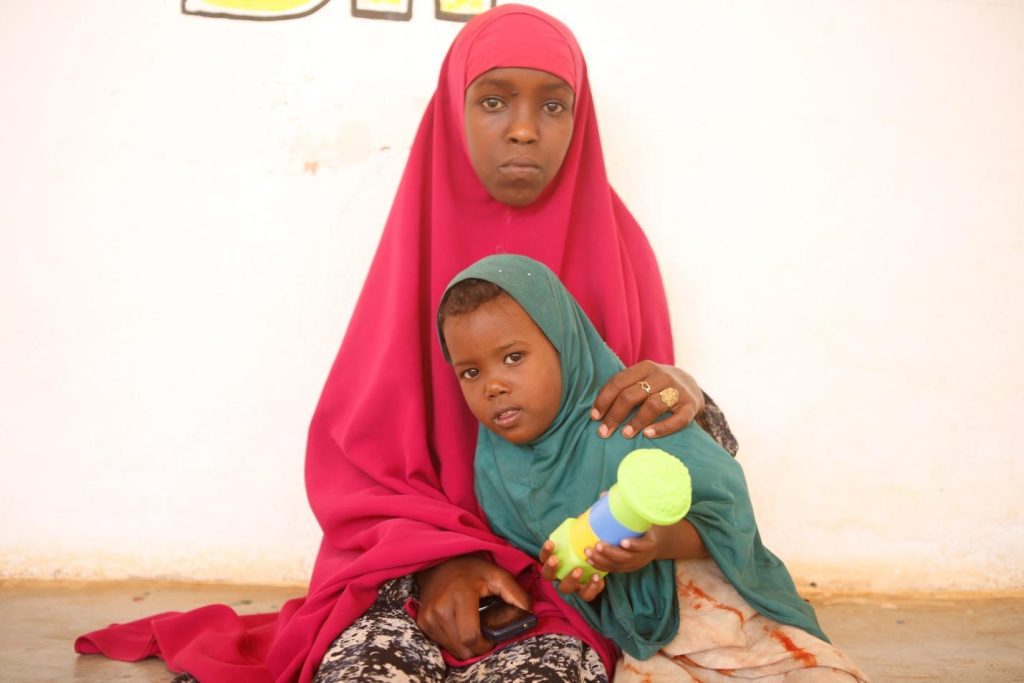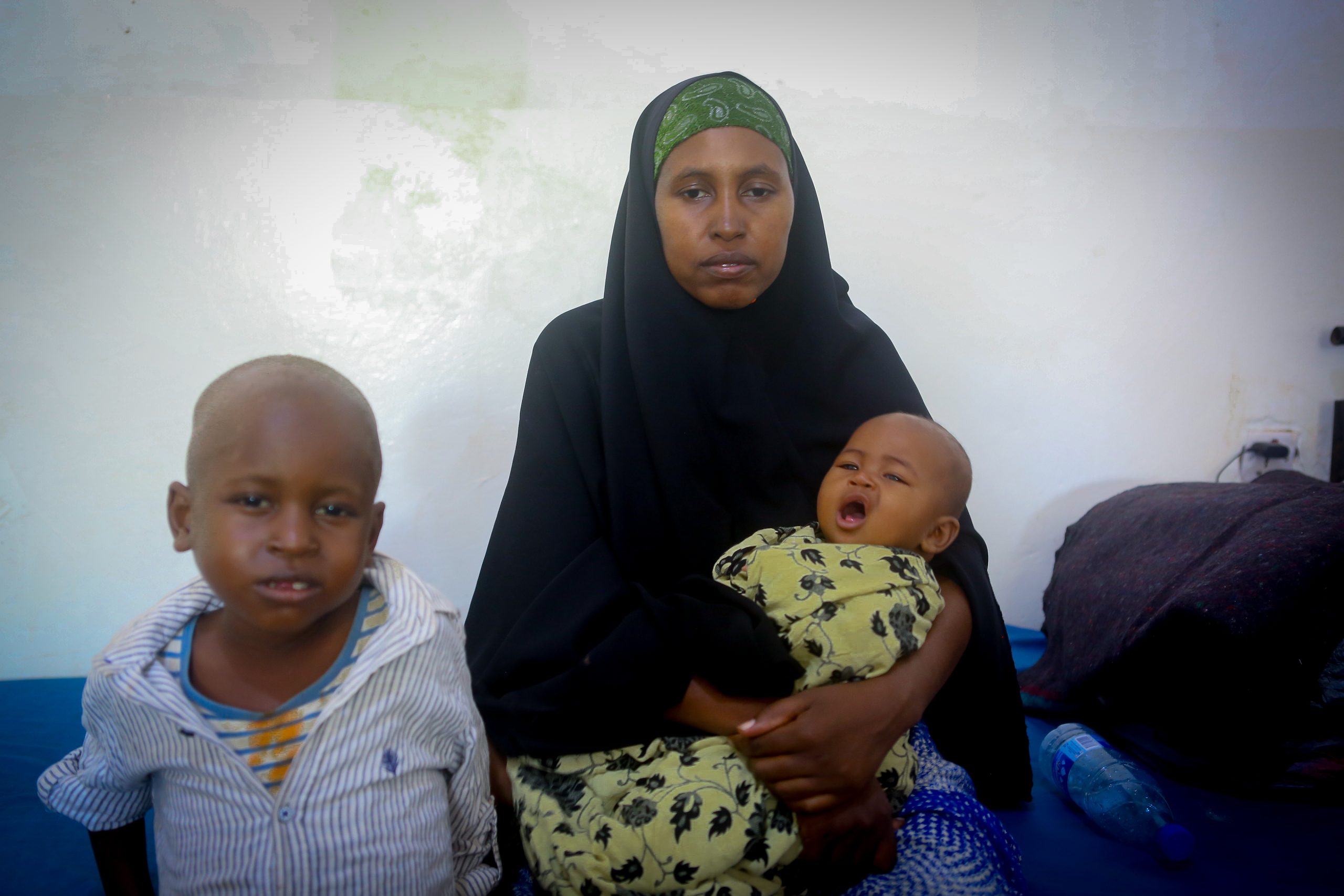Many nomadic and rural population in Somalia lack access to health and nutrition facilities, thus negatively impacting the lives of low-income families who cannot afford to travel to urban centers like Baidoa for treatment. Nearly seven million families have seen a decline in income as a direct result of the severest drought seen in four decades.
One of these affected families is the family of Adan Isaaq Mahad, an elderly man of sixties from Harqaan nomadic home around Dolon Dool village, 43 km to Baidoa. He brought a very weak, underweight, and immobile daughter Nuria Adan to the Bayhaaw stabilization center, in Baidoa. He looked very tired from what seemed like a long-distance walk and sleepless nights.
Nuria, Adan’s three-year-old daughter, had been ill for a year, and he was making a last-ditch effort to find a cure. Her MUAC measurement was just 10 centimeters, and her weight was only 6.8 kilograms, both of which were significantly below average for a kid of her age. In addition, she was bedridden, coughing excessively, vomiting everything she ate, and unable to stand.
Mr. Adan was adamant that Nuria would get over this soon. Having lost four of his children in similar circumstances, he believed “she would never recover” and was making a last-ditch attempt to save his daughter. He has sacrificed goats and, at times, chickens, but to no avail. When his family realized that he was taking Nuria to Baidoa for medical care, they advised him, “Don’t waste your energy and money. She will never recover.”
Young Nuria was admitted to the stabilization center having met the criteria for admission – severely malnourished with complications. The nurses put her on an NG tube since she couldn’t feed properly through her mouth. Normally, most children respond positively to the treatment within a week or so. However, for Nuria, her MUAC and weight remained the same. This worried the health workers.
Nurses under the direction of the stabilization supervisor have begun investigating potential contributing factors to the patient’s lack of progress. They suspected TB may be contributing to Nuria’s health problems. When contacted regarding a possible family history of tuberculosis, Nuria’s father acknowledged that he was in the fourth month of his treatment and that four of his children had become sick like Nurto and tragically died in a similar manner. The nurses then took Nuurto to the Bayhaaw Hospital’s TB lab and got a positive result.
No relatives were available to look after the child throughout her six-month course of TB treatment in Baidoa, and there are no outpatient therapeutic clinics in the Dolon Dool area where she may continue her treatment if freed. Mr. Adan was also leaving Baidoa and begged the nurses to give him the medicine and allow him go with Nuria. This caused the facility’s medical staff additional stress since they concerned that this child would die or relapse. And they did something quite different: they decided to try and save Nuria no matter what.
The stabilization center supervisor, Mss. Aisha tried to convince Adan to leave the child in the stabilization center. However, as a parent, he was finding it hard to do that. He would rather take her home and bury her in his nomadic home like her four siblings. Since he was severely affected by the drought, he has no goats to sell to cover the cost of travelling back and forth, and the stabilization supervisor promised to send him fare whenever he wanted to come and see his daughter in the stabilization center. She also suggested he leave Nuria with them for two weeks to see whether she improved before deciding whether or not to trust them.
To begin the long treatment of TB and malnutrition, Nuria was put on the NG tube again. Fortunately, this time, she was making remarkable progress within a week. She could follow her eyes with the food people eat, something that was hard in the first two weeks of her admission. The nurses felt confident enough to remove the NG tube and start feeding her f-100 formula milk and plummy nuts to help her put on weight.
Mr. Adan was away for a month, and came back to see Nuria in the hospital. Nuria has made significant progress, and the medication has helped her well, and now she is able to sit properly and can walk with wall support, and nurses can hold her hands and walk her within the facility.
Adan’s arrival coincided with a cholera outbreak in Baidoa, where the bed capacity of the health center was terribly overwhelmed. Because of this, Nuria was placed in another ward room together with the other four young children.
“When Mr. Adan came, he straight went to the bed where Nuria was when he left her during the admission,” narrates Aisha, stabilization supervisor. “He could not find her where he left, and he quickly came out, a bit uneasy.” Aisha added.
“Where is my daughter?” asked Mr. Adan.
To avoid surprising him with Nuria’s improvement and to mentally prepare him, Aisha asked him to sit on plastic chair first. She was trying to explain to him how his daughter has improved and she is no longer the Nuria that he brought home a month ago. Then she directed him to the ward room where Nuria was.
Even though he entered the room where his daughter was, Mr. Adan couldn’t immediately recognize Nuria when she was playing on the bed. Then he looked around, searching for Midow, his 14-year-old stepdaughter, whom he had left with Nuria during her admission. She immediately came back from doing some laundry for her sister, Nuria.

A month later, Mr. Adan’s wife, Nuney Anoy, made her first visit to the stabilization center. Adan had already told her about Nuria’s story. She couldn’t wait to see her daughter in two weeks’ time.
Nuney came to the facility when Nuria was playing with other children in the child-friendly space within the facility. But she couldn’t recognize Nuria easily. “This is not Nuria,” said Nuney, a bit unsure. Midow gave her mom the thumbs up with a grin, meaning yes. She rushed over to her child and cradled her in her arms.. “Where will I take her?” said Nuney, alluding to the likelihood of inflicting an evil eye on Nuria if the people in Dolon Dool nomadic home saw the remarkable improvement she made.
Now five months into the program, Nuria has made tremendous improvement, and the stabilization has become another home for her. She has finished the stabilization program, the OTP, and the TSFP, and is waiting to finish her TB medication in a month’s time and will be released to go home.
Nuria’s family was also provided with cash assistance to allow them to buy basic needs, clothes, and other necessities.
The stabilization center is part of the Bayhaaw MCH, which is run by Action Against Hunger through the Caafimaad Plus consortium. This consortium is funded by European Union Humanitarian Aid to help drought-affected population in Somalia with integrated life-saving emergency assistance








